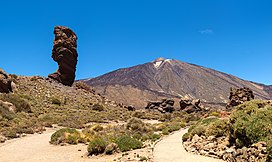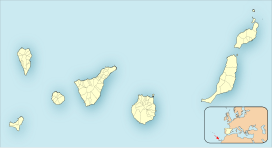This article has multiple issues. Please help improve it or discuss these issues on the talk page. (Learn how and when to remove these messages)
|
| Teide | |
|---|---|
 Teide volcano and Roque Cinchado (left) | |
| Highest point | |
| Elevation | 3,715 m (12,188 ft)[1] |
| Prominence | 3,715 m (12,188 ft)[1] Ranked 40th |
| Listing | Country high point Ultra |
| Coordinates | 28°16′23″N 16°38′22″W / 28.27306°N 16.63944°W[2] |
| Geography | |
| Location | Tenerife, Canary Islands, Spain |
| Geology | |
| Mountain type | Stratovolcano atop basalt shield volcano |
| Last eruption | 18 November 1909 |
| Climbing | |
| First ascent | 1582 |
| Easiest route | Scramble |

Teide, or Mount Teide, (Spanish: El Teide, Pico del Teide, pronounced [ˈpiko ðel ˈtejðe], "Peak of Teide") is a volcano on Tenerife in the Canary Islands, Spain. Its summit (at 3,715 m (12,188 ft))[1][a] is the highest point in Spain and the highest point above sea level in the islands of the Atlantic. If measured from the ocean floor, its height of 7,500 m (24,600 ft) makes Teide the third-highest volcano in the world,[7] UNESCO and NASA rank it as Earth's third-tallest volcanic structure.[8][9][b] Teide's elevation above sea level makes Tenerife the tenth highest island in the world.
Teide started forming 170,000 years ago due to volcanic activity following a catastrophic landslide. Teide's base is situated in Las Cañadas crater (the remains of an older, eroded, extinct volcano) at a height of around 2,190 m (7,190 ft) above sea level. Teide is an active volcano: its most recent eruption occurred in late 1909 from the El Chinyero vent on the northwestern Santiago rift.[10] The United Nations Committee for Disaster Mitigation designated Teide a Decade Volcano[11] because of its history of destructive eruptions and its proximity to several large towns, of which the closest are Garachico, Icod de los Vinos and Puerto de la Cruz. Teide, Pico Viejo and Montaña Blanca form the Central Volcanic Complex of Tenerife.
The volcano and its surroundings make up Teide National Park, which has an area of 18,900 hectares (47,000 acres) and was named a World Heritage Site by UNESCO in 2007.[8] Teide is the most visited natural wonder of Spain, the most visited national park in Spain and Europe and, by 2015, the eighth most visited in the world,[12] with some 3 million visitors yearly.[13] In 2016, it was visited by 4,079,823 visitors and tourists, reaching a historical record.[14][15] Teide Observatory, a major international astronomical observatory, is located on the slopes of the mountain.
- ^ a b c d "Mapa Físico de España (Physical Map of Spain)". Atlas Nacional de España (National Atlas of Spain). Instituto Geográfico Nacional (Spain). 2012. Archived from the original on April 18, 2023. Retrieved April 18, 2023.
- ^ "Europe: Atlantic Islands – Ultra Prominences" Archived February 14, 2005, at the Wayback Machine on peaklist.org as "Pico de Teide". Retrieved October 16, 2011.
- ^ "1091-4 La Montañeta (Tenerife) map sheet". MTN25 edición impresa: 2' (National Topographic Map 1:25000 second edition). Instituto Geográfico Nacional (Spain). 2014. Retrieved October 18, 2018.
- ^ "Altitudes de las provincias (List of highest points in the provinces of Spain)". Datos geográficos y toponimia (Geographical data and place names). Instituto Geográfico Nacional (Spain). 2020. Archived from the original on October 23, 2020. Retrieved May 19, 2020.
- ^ "What is the highest point on Earth as measured from Earth's center?". Ocean Facts. NOAA. Archived from the original on February 2, 2017. Retrieved January 31, 2017.
- ^ "Hawaii Volcanoes National Park". National Park Service. 2005. Archived from the original on February 2, 2017. Retrieved January 31, 2017.
- ^ After Mauna Kea[5] and Mauna Loa[6] at 10.2 km (6.3 mi).
- ^ a b "Teide National Park". World Heritage List. UNESCO. Archived from the original on June 12, 2022. Retrieved January 18, 2009.
- ^ "Teide, Canary Islands". Visible Earth. NASA. August 11, 2009. Retrieved January 31, 2017.
- ^ Carracedo, Juan Carlos; Troll, Valentin R., eds. (2013). "Teide Volcano". Active Volcanoes of the World. doi:10.1007/978-3-642-25893-0. ISBN 978-3-642-25892-3. ISSN 2195-3589. S2CID 127366439. Archived from the original on August 14, 2023. Retrieved November 19, 2023.
- ^ http://vulcan.wr.usgs.gov/Volcanoes/DecadeVolcanoes/ Archived February 21, 2011, at the Wayback Machine Decade Volcanoes – USGS
- ^ "En las entrañas del volcán". elespanol.com. March 21, 2016. Archived from the original on April 19, 2021. Retrieved April 9, 2018.
- ^ "Parque Nacional del Teide. Ascenso, Fauna, Flora..." Archived from the original on November 22, 2022. Retrieved March 21, 2016.
- ^ Plasencia, M. (April 11, 2017). "El Teide bate récord de visitantes y supera los cuatro millones". laopinion.es. La Opinión de Tenerife. Archived from the original on July 28, 2017. Retrieved April 9, 2018.
- ^ "El Teide bate su récord de visitantes en 2016, con más de cuatro millones". Europa Press. April 11, 2017. Archived from the original on August 12, 2017. Retrieved April 9, 2018.
Cite error: There are <ref group=lower-alpha> tags or {{efn}} templates on this page, but the references will not show without a {{reflist|group=lower-alpha}} template or {{notelist}} template (see the help page).
